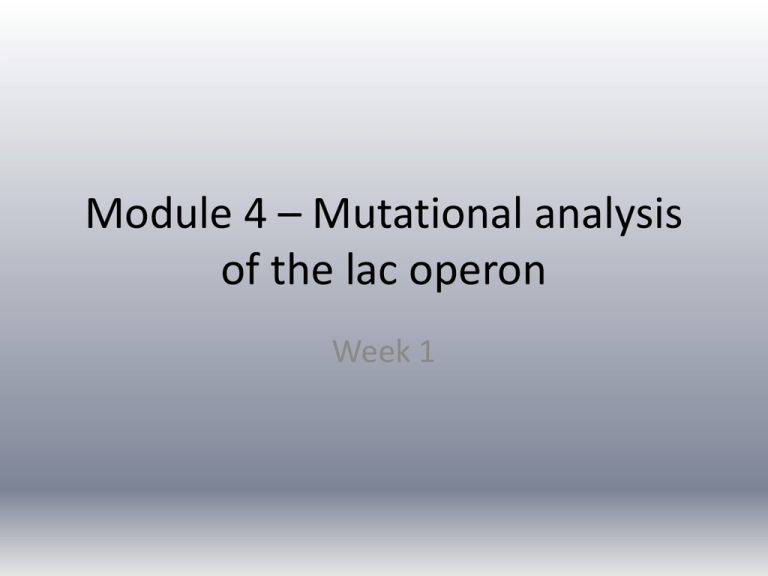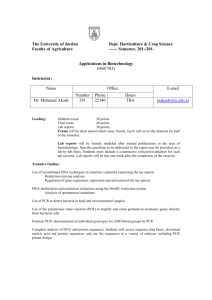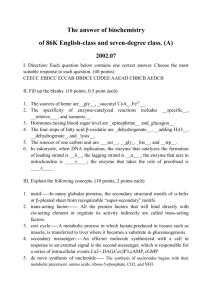Mutation - Pubpages
advertisement

Module 4 – Mutational analysis of the lac operon Week 1 Overview • Week 1: Bioinformatics to identify mutations in DNA and analyze restriction enzyme maps • Week 2: Confirm mutations using RE digestion and agarose gel electrophoresis • Week 3: Oral presentations of the lac operon mutants we discover. Structure of the E. coli lac operon CAP -35 -10 Oper. Start LacZ coding region • Operons are regulatory units in bacterial genomes • Promoter region (above) controls when transcription of mRNA from DNA template occurs • Lac operon controls expression of three genes needed for metabolizing lactose – LacZ, LacY and LacA genes Nucleotide sequence in promoter region of lac operon CAP -35 -10 Oper. Start LacZ coding region CAACGCAATTAATGTGAGTTAGCTCACTCATTAGGCACCCCAGG CAP binding site CTTTACACTTTATGCTTCCGGCTCGTATGTTGTGTGGAATTGTGA -35 site -10 site Operator/LacI… GCGGATAACAATTTCACACAGGAAACAGCTATGACCATGATT …binding site • • • • • Transcription start Methionine start CAP = cAMP binding protein (CAP) recognition site -35 and -10 are transcription factor binding sites Operator/LacI = Operator region when the LacI inhibitor protein binds Trans. Start = place where RNA polymerase binds to start transcription ATG codon is the starting methionine of the coding region for β-Gal Regulation of the lac operon by sugar Glu Lac CAP -35 -10 Oper. Start Coding region RNA polymerase binds and transcribes DNA • Absence of glucose and presence of lactose required for activation of transcription of the lac operon. Plasmids are autonomous, self-replicating DNA molecules • Plasmids are closed, circular, double-stranded DNA • Small size (<10 kb) allows efficient transfer into cell • Autonomously replicate (separate from chromosomal DNA of host) • Selectable marker (e.g., antibiotic resistance gene, ampicillin) discriminates plasmid-containing cells • Multiple cloning site (MCS) allows insertion of foreign DNA using restriction enzymes Amp. pBS (3 kB) Ori. MCS Using plasmids as carriers of genetic material • Example shown is genomic DNA • Insert DNA fragments into cloning vector • Once created, plasmids can be purified and analyzed for genetics mutations Inserting the lac operon into the plasmid allows us to look for mutations • A set of plasmids is available in which the wild-type lac operon and mutant lac operons have been cloned into a plasmid • Increased size of plasmid due to insert • Easy to purify, sequence the DNA, and analyze using restriction enzymes lac operon Amp. pLac/WT (6 kB) Ori. DNA sequences for lac operon will be provided to you • pLac/WT is the DNA sequence for the lac operon without mutations • Mutants m1 through m7 will be compared with the WT for genetic variations • Types of mutations you might find: – – – – Substitutions Insertions (frameshift?) Deletions (frameshift?) Truncation Compare DNA sequences using a program that performs alignment • Biology Workbench 3.2 will be used • Enter sequences of WT and your mutant • Using ALIGN program to perform alignment Alignment results • A portion of the alignment results shown below • Length of sequences reported • Identify number of identities/mis-matches Restriction endonucleases: molecular scissors • Enzymes that cleave double-stranded DNA at specific restriction site on DNA • Recognize very specific base sequences – Usually palindromic sequences • Two strands are identical when read in same polarity – Typically 4-8 nucleotides in length – Cleavage of bond on each strand often leads to “sticky ends” with nucleotide overhang • Blunt ends occur when restriction enzyme does not leave overhang Many restriction enzymes create “sticky ends” • NdeI: 5’ CATATG 3’ GTATAC BamHI: 5’ GGATCC 3’ CCTAGG Restriction map • Use the full-length sequence of lac operon inserted into plasmid backbone • Analyze all possible RE cutting sites with program TACG • Carry out analysis for both WT and mutant. • Look for differences in the RE cutting pattern that can be used as a diagnostic Results from TACG program for pLac/WT • Selected Sequence(s) pLac/WT insert • Enzymes that DO NOT MAP to this sequence • Total Number of Hits per Enzyme • Cut Sites by Enzyme • Pseudo-Gel Map of Digestions • Fragment Sites by Enzyme • Linear Map of Sequence Enzymes that DO NOT MAP to this sequence: • • • • • • • • • • • • • • AarI AclI AflII AgeI AhdI AjuI AjuI AloI AloI ArsI ArsI AscI AsiSI AvrII • • • • • • • • • • • • • • BarI BarI BbeI BbvCI BglII BmgBI BmtI BplI BpuEI BsaI BseRI BsmI BspEI BspHI •BsrDI •BsrGI •BstAPI •BstEII •CspCI •CspCI •EcoNI •FalI •FseI •FspAI •KasI •KflI •MfeI •MreI •MscI •NaeI •NarI • • • • • • • • • • • • • • NcoI NgoMIV NheI NruI NsiI PacI PasI PmeI PmlI PpiI PpiI PshAI PsiI PsrI •PsrI •RsrII •SapI •SbfI •ScaI •SexAI •SfiI •SfoI •SgrAI •SgrDI •SnaBI •SphI •SrfI •StuI •SwaI •Tth111I •XbaI •XmnI Cut Sites by Enzyme (examples) • • • • • • AatII G_ACGT'C (0 Err) - 1 Cut(s) 1011 AbsI CC'TCGA_GG (0 Err) - 1 Cut(s) 286 Acc65I G'GTAC_C (0 Err) - 2 Cut(s) 271 568 AcuI CTGAAGnnnnnnnnnnnnnn_nn' (0 Err) - 1 Cut(s) 1122 AfeI AGC'GCT (0 Err) - 1 Cut(s) 2223 AleI CACnn'nnGTG (0 Err) - 4 Cut(s) 1728 2677 3223 3458 Determine size of fragments produced • 0 cuts will leave plasmid DNA supercoiled • 1 cut will linearize DNA; need to know total bp to predict its size • 2 cuts will first linearize and then generate two different fragment • Acc65I - 2 Cut(s) at position 271 and 568 – 568-271 = 297 bp – Second piece is 5911 – 297 = 5614 bp – Separating RE digest shows two bands at these sizes Comparing WT and mutant RE maps can reveal differences in predicted fragment size • Look for appearance or disappearance of a restriction site • Look for a large shift in the size of a fragment of the mutant versus WT DNA Restriction Wild-type:position of Enzyme site(s) & size of fragments mutant: Position of site(s) # cuts & size of fragments Position: Position: Size: Size: Position: Position: Size: Size: Position: Position: BamHI Size: Size: BsrGI Position: Position: AatII AseI # cuts Homework • Email or give to Krist by next Tuesday • Exercise #1 – Copy of your alignment – Answers to three questions • Exercise #2 – Copy of your restriction analysis output – Answers to two questions • Next time: use the restriction analysis to cut the DNA and run gels



